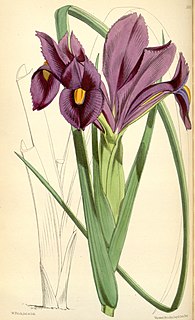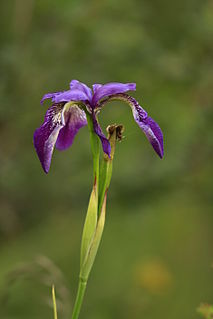
The Royal Botanic Garden Edinburgh (RBGE) is a scientific centre for the study of plants, their diversity and conservation, as well as a popular tourist attraction. Founded in 1670 as a physic garden to grow medicinal plants, today it occupies four sites across Scotland—Edinburgh, Dawyck, Logan and Benmore—each with its own specialist collection. The RBGE's living collection consists of more than 13,302 plant species, whilst the herbarium contains in excess of 3 million preserved specimens.

Chefchaouen, also known as Chaouen, is a city in northwest Morocco. It is the chief town of the province of the same name, and is noted for its buildings in shades of blue. Chefchaouen is situated just inland from Tangier and Tétouan.

Pristimantis katoptroides is a species of frog in the family Strabomantidae. It is found in the eastern slopes of the Andes of Ecuador and Cordillera Central and eastern Andean foothills in northwestern Peru. The specific name katoptroides is Greek for "mirror-like" and refers to the similarity of this species to Pristimantis crucifer, but being found on the other side of the Andes. Common name Puyo robber frog has been proposed for it.
Charles Edward Hubbard was a British botanist, specialising in agrostology – the study of grasses. He was considered "the world authority on the classification and recognition of grasses" in his time.
Hyacinthoides paivae is a species of bluebell in the genus Hyacinthoides native to the north-western part of the Iberian Peninsula. It lives chiefly in shady woodlands, and grows up to 45 cm (18 in) tall, producing a cluster of up to 18 pale blue flowers in spring. It was formally described in 1996, having previously been identified as belonging to the related species H. italica.

Iris histrio, the Syrian iris, is a species in the genus Iris, it is classified in the subgenus Hermodactyloides and section Reticulatae. It is a bulbous perennial from Central Asia: Kyrgyzstan, Israel, Lebanon, Syria and southern Turkey.

Subgenus Xiphium is a subgenus of Iris. If considered a separate genus from Iris, it is known as genus Xiphion.

Iris tingitana is a species in the genus Iris in the subgenus of Xiphium.
Iris serotina is a species in the genus Iris, it is also in the subgenus Xiphium. It is a bulbous perennial from southern Europe, found in Spain and Morocco.

Iris filifolia is a species in the genus Iris, it is also in the subgenus Xiphium. It is a bulbous perennial from North Africa and Europe. It has thin leaves, summer flowers in shades of red-purple.
George Hill Mathewson Lawrence was an American botanist, writer and professor of botany who helped establish the 'Liberty Hyde Bailey Hortorium', the Hunt Botanical Library and the Huntia journal. He was also an avid book collector, including books on the history of Rhode Island, historic books and botanical art.

Iris clarkei is a species in the genus Iris, also the subgenus of Limniris and in the series Sibiricae. It is a rhizomatous herbaceous perennial, from Asia, including north east India, Nepal, Tibet, Bhutan, Burma and in China. It has grey-green leaves, long and thin green stem and violet, to dark blue, to blue or reddish purple flowers.

Iris spuria subsp. maritima is a species of the genus Iris, part of a subgenus series known as Iris subg. Limniris and in the series Iris ser. Spuriae. It is a subspecies of Iris spuria, a beardless, rhizomatous perennial plant, from coastal regions Europe and north Africa with deep blue-violet flowers.

Iris glaucescens is a plant species in the genus Iris, it is also in the subgenus Iris. It is a rhizomatous perennial, found in Russia, Kazakhstan, Mongolia and China. It has blue-grey sickle-shaped leaves, slender stem, and spring flowers in blue-violet, pale violet, lilac-purple, to deep purple, to light bluish, and almost white shades. It is rarely cultivated as an ornamental plant in temperate regions. It was merged with another similar iris in the region, and became a synonym of Iris scariosa, before being divided into two separate species again. Although some sources still call it a synonym of Iris scariosa.

Iris subbiflora is a plant species in the genus Iris, it is also in the subgenus Iris. It is a rhizomatous perennial, from Portugal and Spain in Europe. It has evergreen broad leaves, forming dense clumps, it has dwarf stems in late spring,, with 1 upright fragrant flower, in shades of purple, light red purple, grey-blue, blue-violet, or dark violet. It has a beard which is generally blue, purple, or violet, but can fade to white, dull yellow, or dark yellow. After being found in 1804, it was once a separate species until the late 70s, when it was reclassified as subspecies of Iris lutescens, and renamed Iris lutescens subsp. subbiflora. But in the 80s it was returned to an independent species but some authors and references still class the species as a synonym or subspecies. It is cultivated as an ornamental plant in temperate regions.

Alba González Villa, known professionally as Alba Flores, is a Spanish actress. She is best known for her roles as Saray Vargas in Vis a Vis and Nairobi in La Casa de Papel . She identifies as lesbian.
Étienne Marcellin Granié-Blanc, religious name Frère Sennen (1861–1937), was a French botanist and member (Brother) of the Catholic order Frères des écoles chrétiennes. He collected plants in France, Spain, and Morocco.
Mark Spencer is a British forensic botanist and botanical consultant. He also monitors the changing composition of urban wildlife. He is the honorary botany curator for the Linnean Society of London.
Toño Cedeño is a doctor in art history, theologian, oculist, visual artist and founder of the Oqli Collection.











